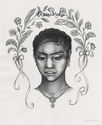
19th, 20th & 21st Century Fine Prints
707-546-7352 · fax 707-546-7924 · web: www.annexgalleries.com · email: artannex@aol.com
Maxine Albro Biography
Maxine Albro
American
1893–1966
Biography
Maxine Albro was born in Ayrshire, Iowa on January 20, 1893. In 1920, she moved to San Francisco, California where she studied at the California School of Fine Arts from 1923 to 1925. A year later, she enrolled in the Art Students League in New York. In the early 1920s, she lived in Burlingame, California, near San Francisco. In 1927, she studied at Académie de la Grande Chaumière in Paris, before embarking to Mexico around 1929, where she would make the acquaintance of Mexican painter Diego Rivera, about whom she said "Watching Diego [paint] was very beneficial to me," she said. In 1938 Albro became an assistant to Rivera and studied with Pablo O'Higgins, with whom she painted frescoes.
In the 1930s she worked for the Federal Public Works of Art Project. On one of her many trips to Mexico she studied mural painting with Diego Rivera. After marrying sculptor Parker Hall in 1938, they settled in Carmel on the Monterey Peninsula. Although she specialized in Spanish and Mexican motifs, her work also includes landscapes and street scenes gleaned from her world travels.
Some of her work figured in a controversy apart from that at Coit Tower: four “portly Roman sybils” that she executed at the Ebell Women's Club in Los Angeles offended some of its members; they rescinded approval of her frescoes which, though intended to last “as long as the concrete of the wall lasted,” were destroyed in 1935, despite the fact that several prominent art critics, including the young Arthur Miller, rose to her defense. Also destroyed was her mosaic of animals over the entrance to Anderson Hall at the University of California Extension in San Francisco. She created fresco decorations for many private homes, including that of Col. Harold Mack in Monterey. Her easel art was popular in local and national museums.
Maxine Albro died in Los Angeles, California on July 19, 1966.


